Hellenistic Greek Art Greek Art if Alexander the Great




From left to correct:
the Venus de Milo, discovered at the Greek isle of Milos, 130–100 BC, Louvre
the Winged Victory of Samothrace, from the island of Samothrace, 200–190 BC, Louvre
Pergamon Altar, Pergamon Museum, Berlin.
Hades abducting Persephone, fresco in the majestic tomb at Vergina, Macedonia, Hellenic republic, c. 340 BC
Hellenistic art is the fine art of the Hellenistic period more often than not taken to brainstorm with the death of Alexander the Neat in 323 BC and cease with the conquest of the Greek earth by the Romans, a procedure well underway by 146 BCE, when the Greek mainland was taken, and essentially catastrophe in thirty BCE with the conquest of Ptolemaic Egypt following the Boxing of Actium. A number of the all-time-known works of Greek sculpture vest to this period, including Laocoön and His Sons, Venus de Milo, and the Winged Victory of Samothrace. Information technology follows the period of Classical Greek fine art, while the succeeding Greco-Roman art was very largely a continuation of Hellenistic trends.
The term Hellenistic refers to the expansion of Greek influence and dissemination of its ideas following the decease of Alexander – the "Hellenizing" of the world,[1] with Koine Greek as a common language.[2] The term is a modern invention; the Hellenistic World not only included a huge area covering the whole of the Aegean Body of water, rather than the Classical Greece focused on the Poleis of Athens and Sparta, but also a huge time range. In artistic terms this means that in that location is huge multifariousness which is often put under the heading of "Hellenistic Art" for convenience.
One of the defining characteristics of the Hellenistic period was the segmentation of Alexander's empire into smaller dynastic empires founded by the diadochi (Alexander's generals who became regents of different regions): the Ptolemies in Egypt, the Seleucids in Mesopotamia, Persia, and Syria, the Attalids in Pergamon, etc. Each of these dynasties practiced a royal patronage which differed from those of the city-states. In Alexander's entourage were three artists: Lysippus the sculptor, Apelles the painter, and Pyrgoteles the gem cutter and engraver.[3] The menstruum after his death was ane of smashing prosperity and considerable extravagance for much of the Greek world, at least for the wealthy. Royalty became important patrons of art. Sculpture, painting and architecture thrived, only vase-painting ceased to be of cracking significance. Metalwork and a wide variety of luxury arts produced much fine fine art. Some types of pop fine art were increasingly sophisticated.
There has been a trend in writing history to draw Hellenistic art equally a decadent style, following the Golden Age of Classical Greece. The 18th century terms Bizarre and Rococo have sometimes been applied to the art of this circuitous and individual menstruum. A renewed involvement in historiography equally well every bit some recent discoveries, such as the tombs of Vergina, may permit a better appreciation of the period.
Architecture [edit]
In the architectural field, the dynasties following Hector resulted in vast urban plans and large complexes which had mostly disappeared from city-states by the 5th century BC.[5] The Doric Temple was virtually abased.[6] This metropolis planning was quite innovative for the Greek earth; rather than manipulating space past correcting its faults, building plans conformed to the natural setting. 1 notes the appearance of many places of entertainment and leisure, notably the multiplication of theatres and parks. The Hellenistic monarchies were advantaged in this regard in that they oft had vast spaces where they could build big cities: such as Antioch, Pergamon, and Seleucia on the Tigris.
It was the time of gigantism: thus information technology was for the 2nd temple of Apollo at Didyma, situated 20 kilometers from Miletus in Ionia. Information technology was designed by Daphnis of Miletus and Paionios of Ephesus at the end of the 4th century BC, merely the construction, never completed, was carried out upward until the 2d century AD. The sanctuary is i of the largest ever constructed in the Mediterranean region: inside a vast court (21.seven metres by 53.6 metres), the cella is surrounded by a double pillar of 108 Ionic columns about 20 metres tall, with richly sculpted bases and capitals.[7]
Athens [edit]
The Corinthian order was used for the beginning fourth dimension on a full-calibration building at the Temple of Olympian Zeus.[viii]
Olynthus [edit]
The aboriginal metropolis of Olynthus was one of the architectural and creative keystones in establishing a connection betwixt the Classical and Hellenistic worlds.
Over 100 homes were found at the Olynthus city site. Interestingly, the homes and other compages were incredibly well preserved. This allows united states of america to amend sympathize the activities that took place in the homes and how space within the homes was organized and utilized.
Homes in Olynthus were typically squarer in shape. The desired dwelling was not necessarily big or extravagant, just rather comfy and practical. This was a marker of civilization that was extremely prominent in Greek civilisation during the Hellenistic menstruum and beyond. Living a civilized life involved maintaining a sturdy living space, thus many brick-like materials were used in the construction of the homes. Rock, wood, mudbrick, and other materials were commonly used to build these dwellings.
Another element that was increasingly popular during the Hellenistic period was the addition of a courtyard to the home. Courtyards served as a calorie-free source for the dwelling as Greek houses were closed off from the outside to maintain a level of privacy. At that place have been windows found at some home sites, but they are typically loftier off the ground and small. Because of the issue of privacy, many individuals were forced to compromise on light in the home. Well-lit spaces were used for entertaining or more than public activity while the private sectors of the home were dark and closed off which complicated housework.
Courtyards were typically the focus of the home every bit they provided a space for entertaining and a source of light from the very interior of the domicile. They were paved with cobblestones or pebbles most oft, but there have been discoveries of mosaicked courtyards. Mosaics were a wonderful way for the family to express their interests and beliefs besides equally a way to add décor to the home and make it more than visually appealing. This creative affect to homes at Olynthus introduces another element of civilized living to this Hellenistic society.[ix]
Pergamon [edit]
Pergamon in particular is a feature example of Hellenistic compages. Starting from a simple fortress located on the Acropolis, the various Attalid kings fix a colossal architectural complex. The buildings are fanned out effectually the Acropolis to take into account the nature of the terrain. The agora, located to the south on the lowest terrace, is bordered by galleries with colonnades (columns) or stoai. It is the starting time of a street which crosses the unabridged Acropolis: information technology separates the administrative, political and military buildings on the east and acme of the rock from the sanctuaries to the w, at mid-meridian, among which the most prominent is that which shelters the awe-inspiring Pergamon Altar, known as "of the twelve gods" or "of the gods and of the giants", i of the masterpieces of Greek sculpture. A colossal theatre, able to contain virtually ten,000 spectators, has benches embedded in the flanks of the colina.[10]
Sculpture [edit]

Pliny the Elder, after having described the sculpture of the classical period notes: Cessavit deinde ars ("then fine art disappeared").[11] According to Pliny's assessment, sculpture declined significantly after the 121st Olympiad (296–293 BC). A period of stagnation followed, with a brief revival after the 156th (156–153 BC), but with nothing to the standard of the times preceding it.[12]
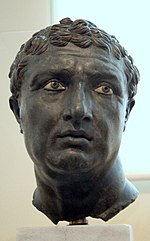
Bronze portrait of an unknown sitter, with inlaid eyes, Hellenistic period, 1st century BC, found in Lake Palestra of the Isle of Delos.
During this period sculpture became more naturalistic, and also expressive; there is an interest in depicting extremes of emotion. On top of anatomical realism, the Hellenistic artist seeks to represent the character of his subject, including themes such every bit suffering, sleep or old historic period. Genre subjects of common people, women, children, animals and domestic scenes became acceptable subjects for sculpture, which was commissioned by wealthy families for the beautification of their homes and gardens; the Male child with Thorn is an example.

The Barberini Faun, 2nd-century BC Hellenistic or 2nd-century Advertizing Roman copy of an earlier bronze
Realistic portraits of men and women of all ages were produced, and sculptors no longer felt obliged to depict people as ideals of beauty or physical perfection.[13] The world of Dionysus, a pastoral idyll populated past satyrs, maenads, nymphs and sileni, had been often depicted in earlier vase painting and figurines, but rarely in full-size sculpture. The Old Drunkard at Munich portrays without reservation an sometime woman, thin, haggard, clutching confronting herself her jar of wine.[14]
Portraiture [edit]
The period is therefore notable for its portraits: Ane such is the Barberini Faun of Munich, which represents a sleeping satyr with relaxed posture and anxious face, perchance the casualty of nightmares. The Belvedere Torso, the Resting Satyr, the Furietti Centaurs and Sleeping Hermaphroditus reverberate similar ideas.[fifteen]
Another famous Hellenistic portrait is that of Demosthenes by Polyeuktos, featuring a well-done face and clasped hands.[12]
Privatization [edit]
Another phenomenon of the Hellenistic historic period appears in its sculpture: privatization,[xvi] [17] seen in the recapture of older public patterns in decorative sculpture.[eighteen] Portraiture is tinged with naturalism, under the influence of Roman fine art.[19] New Hellenistic cities were springing upwards all over Egypt, Syria, and Anatolia, which required statues depicting the gods and heroes of Greece for their temples and public places. This made sculpture, similar pottery, an manufacture, with the consequent standardization and some lowering of quality. For these reasons many more Hellenistic statues have survived than is the case with the Classical period.
2nd classicism [edit]
Hellenistic sculpture repeats the innovations of the so-chosen "2nd classicism": nude sculpture-in-the-circular, assuasive the statue to be admired from all angles; written report of draping and effects of transparency of clothing, and the suppleness of poses.[20] Thus, Venus de Milo, fifty-fifty while echoing a classic model, is distinguished by the twist of her hips.
"Baroque" [edit]
The multi-figure group of statues was a Hellenistic innovation, probably of the tertiary century, taking the ballsy battles of earlier temple pediment reliefs off their walls, and placing them as life-size groups of statues. Their style is often called "baroque", with extravagantly contorted trunk poses, and intense expressions in the faces. The Laocoön Group, detailed below, is considered ane of the prototypical examples of the Hellenistic baroque mode.[21]
Pergamon [edit]

Pergamon did not distinguish itself with its architecture alone: information technology was also the seat of a bright school of sculpture known every bit Pergamene Baroque.[22] The sculptors, imitating the preceding centuries, portray painful moments rendered expressive with three-dimensional compositions, ofttimes V-shaped, and anatomical hyper-realism. The Barberini Faun is one example.
Gauls [edit]
Attalus I (269–197 BC), to commemorate his victory at Caicus against the Gauls;— called Galatians past the Greeks – had two series of votive groups sculpted: the start, consecrated on the Acropolis of Pergamon, includes the famous Gaul killing himself and his wife, of which the original is lost; the 2d group, offered to Athens, is composed of pocket-size bronzes of Greeks, Amazons, gods and giants, Persians and Gauls.[23] Artemis Rospigliosi in the Louvre is probably a re-create of 1 of them; as for copies of the Dying Gaul, they were very numerous in the Roman period. The expression of sentiments, the forcefulness of details – bushy hair and moustaches here – and the violence of the movements are characteristic of the Pergamene mode.[24]
Great Altar [edit]
These characteristics are pushed to their peak in the friezes of the Great Altar of Pergamon, decorated under the order of Eumenes II (197–159 BC) with a gigantomachy stretching 110 metres in length, illustrating in the rock a poem composed especially for the courtroom. The Olympians triumph in information technology, each on his side, over Giants – near of which are transformed into savage beasts: serpents, birds of prey, lions or bulls. Their mother Gaia comes to their aid, but can do nothing and must spotter them twist in pain under the blows of the gods.[25]
Colossus of Rhodes [edit]
I of the few city states who managed to maintain full independence from the control of any Hellenistic kingdom was Rhodes. After holding out for i year under siege past Demetrius Poliorcetes (305–304 BCE), the Rhodians built the Colossus of Rhodes to commemorate their victory.[26] With a superlative of 32 meters, it was i of the Seven Wonders of the Ancient World. Progress in bronze casting made it possible for the Greeks to create big works. Many of the big bronze statues were lost – with the bulk beingness melted to recover the material.
Laocoön [edit]
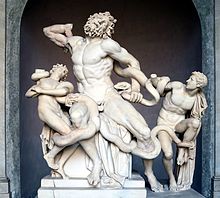
Discovered in Rome in 1506 and seen immediately by Michelangelo,[27] kickoff its huge influence on Renaissance and Bizarre art. Laocoön, strangled by snakes, tries desperately to loosen their grip without affording a glance at his dying sons. The grouping is ane of very few non-architectural ancient sculptures that can be identified with those mentioned past aboriginal writers. Information technology is attributed by Pliny the Elder to the Rhodian sculptors Agesander, Athenodoros, and Polydorus.[27]

The central group of the Sperlonga sculptures, with the Blinding of Polyphemus; cast reconstruction of the group, with at the right the original effigy of the "wineskin-bearer" seen in front end of the cast version.
Johann Joachim Winckelmann, who start articulated the deviation betwixt Greek, Greco-Roman and Roman art, drew inspiration from the Laocoön. Gotthold Ephraim Lessing based many of the ideas in his 'Laocoon' (1766) on Winckelmann's views on harmony and expression in the visual arts.[28]
Sperlonga [edit]
The fragmentary Sperlonga sculptures are another series of "baroque" sculptures in the Hellenistic style, perhaps made for the Emperor Tiberius, who was certainly present at the collapse of the seaside grotto in southern Italy that they decorated.[27] The inscriptions suggest the aforementioned sculptors made it who made the Laocoön group,[29] or possibly their relations.
"Rococo" [edit]

The satyr from the Hellenistic sculpture group "The Invitation to the Trip the light fantastic". The sculpture group is seen as a prime case of the "Rococo" trend in Hellenistic sculpture. In the sculpture group the satyr was depicted together with a seated female. This sculpture is now in the Musée du Louvre, Paris.
The "Baroque" traits in Hellenistic fine art, predominately sculpture, have been contrasted with a contemporary trend that has been described as "Rococo". The concept of a Hellenistic "Rococo" was coined past Wilhelm Klein in the early on 20th century.[30] Dissimilar the dramatic "Bizarre" sculptures, the "Rococo" trend emphasized playfull motifs, such as satyrs and nymphs. Wilhelm Klein considered the sculpture group "The Invitation to the Dance" to be a prime number case of the trend.[31] [32] Also lighthearted depictions of Aphrodite, the goddess of love, and Eros, were seen as typical (every bit seen, for instance, in the so-called Slipper Slapper Group depicted below). It has later been argued that the preference for the "Rococo" motifs in Hellenistic sculpture tin be tied to a changed use of sculpture in general. Private sculpture collecting became more common during the later Hellenistic flow, and in such collections there seems to have been a preference for the kinds of motifs characterized as "Rococo".[33]
Neo-Attic [edit]
From the 2nd century the Neo-Attic or Neo-Classical manner is seen by different scholars equally either a reaction to baroque excesses, returning to a version of Classical style, or as a continuation of the traditional style for cult statues.[34] Workshops in the manner became mainly producers of copies for the Roman marketplace, which preferred copies of Classical rather than Hellenistic pieces.[35]
-
Gravestone of a woman with her child slave attending to her, c. 100 BC (early period of Roman Greece)
-
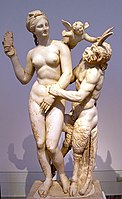
The and so-called Slipper Slapper Group: Aphrodite and Eros fighting off the advances of Pan. Marble, Hellenistic artwork from the late 2nd century BC.
-

Hellenistic sculpture fragments from the National Archaeological Museum, Athens
Paintings and mosaics [edit]
Paintings and mosaics were important mediums in art, but no examples of paintings on panels have survived the autumn to the Romans. It is possible to get some thought of what they were like from related media, and what seem to be copies of or loose derivations from paintings in a wider range of materials.
Landscape [edit]
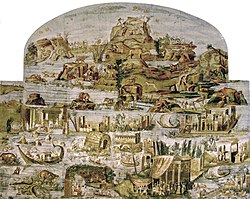
Perhaps the most hitting element of Hellenistic paintings and mosaics is the increased use of landscape.[36] Landscapes in these works of art are representative of familiar naturalistic figures while too displaying mythological and sacro-idyllic elements.[37] Landscape friezes and mosaics were ordinarily used to display scenes from Hellenistic poetry such every bit that by Herondas and Theocritos. These landscapes that expressed the stories of Hellenistic writers were utilized in the dwelling to emphasize that family's teaching and knowledge about the literary world.[38]
Sacro-idyllic means that the almost prominent elements of the artwork are those related to sacred and pastoral themes.[39] This style that emerged virtually prevalently in Hellenistic fine art combines sacred and profane elements, creating a dreamlike setting.[twoscore] Sacro-idyllic influences are conveyed in the Roman mosaic "Nile Mosaic of Palestrina" which demonstrates fantastical narratives with a color scheme and commonplace components that illustrate the Nile in its passage from Federal democratic republic of ethiopia to the Mediterranean. The inclusion of Hellenistic backgrounds can likewise exist seen in works throughout Pompeii, Cyrene, Alexandria. Moreover, specifically in Southern Russia, floral features and branches tin can be found on walls and ceilings strewn in a disordered however conventional way, mirroring a late Greek manner.[41] In addition, "Cubiculum" paintings constitute in Villa Boscoreale include vegetation and a rocky setting in the background of detailed paintings of grand architecture.
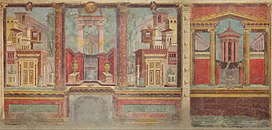
Roman fresco painting known every bit "Cubiculum" (bedroom) from the Villa of P. Fannius Synistor at Boscoreale, 50–xl B.C. Metropolitan Museum of Art 03.14.13a–g.
Wall paintings [edit]

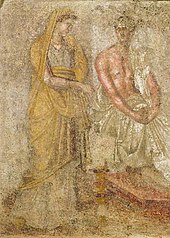
Hellenistic terra cotta funerary wall painting, 3rd century BC
Wall paintings began appearing more prominently in the Pompeian period. These wall paintings were not only displayed in places of worship or in tombs.[42] Often, wall paintings were used to decorate the home. Wall paintings were common in private homes in Delos, Priene, Thera, Pantikapaion, Olbia, and Alexandria.[42]
Few examples of Greek wall paintings have survived the centuries. The most impressive, in terms of showing what high-quality Greek painting was like, are those at the Macedonian royal tombs at Vergina. Though Greek painters are given tribute to bringing fundamental ways of representation to the Western World through their art. Three main qualities unique to Hellenistic painting style were 3-dimensional perspective, the use of low-cal and shade to render form, and trompe-l'œil realism.[43] Very few forms of Hellenistic Greek painting survive except for wooden pinakes panels and those painted on stone. The most famously known stone paintings are found on the Macedonian Tomb at Agios Athanasios.[43]
Researchers accept been limited to studying the Hellenistic influences in Roman frescoes, for case those of Pompeii or Herculaneum. In improver, some of the paintings in Villa Boscoreale clearly repeat lost Hellenistic, Macedonian royal paintings.[44]
Mediums and technique [edit]
Recent excavations from the Mediterranean have revealed the technology used in Hellenistic painting.[45] Wall art of this flow utilized two techniques: secco technique and fresco technique.[45] Fresco technique required layers of lime-rich plaster to and so decorate walls and stone supports.[45] On the other hand, no base was necessary for the secco technique, which used gum standard arabic and egg tempera to paint finalizing details on marble or other rock.[45] This technique is exemplified in the Masonry friezes found in Delos.[45] Both techniques used mediums that were locally accessible, such as terracotta aggregates in the base of operations layers and natural inorganic pigments, synthetic inorganic pigments, and organic substances equally colorants.[45]
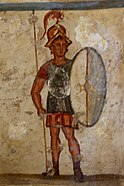
Recent discoveries [edit]
Contempo discoveries include those of chamber tombs in Vergina (1987) in the former kingdom of Macedonia, where many friezes accept been unearthed.[36] For case, in Tomb Ii archaeologists found a Hellenistic-style frieze depicting a lion hunt.[46] This frieze found in the tomb supposedly that of Philip II is remarkable by its composition, the arrangement of the figures in space and its realistic representation of nature.[47] Other friezes maintain a realistic narrative, such equally a symposium and banquet or a military machine escort, and possibly retell historical events.[46]
There is too the recently restored 1st-century Nabataean ceiling frescoes in the Painted House at Niggling Petra in Jordan.[48] As the Nabataeans traded with the Romans, Egyptians, and Greeks, insects and other animals observed in the paintings reflect Hellenism while diverse types of vines are associated with the Greek god, Dionysus.[48]
Contempo archaeological discoveries at the cemetery of Pagasae (close to modernistic Volos), at the edge of the Pagasetic Gulf have brought to light some original works. The excavations of this site led by Dr. Arvanitopoulos may exist connected to diverse Greek painters in the tertiary and 4th centuries and depict scenes that insinuate to the reign of Alexander the Groovy.[49] [50]
In the 1960s, a grouping of wall paintings was found on Delos.[51] It is evident that the fragments of friezes institute were created past a community of painters who lived during the late Hellenistic catamenia.[52] The murals emphasized domestic decoration, conveying the conventionalities these people held that the Delian establishment would remain stable and secure plenty for this artwork to be enjoyed by homeowners for many years to come up.[52]
Mosaics [edit]

Sure mosaics, nevertheless, provide a pretty good thought of the "k painting" of the period: these are copies of frescoes. This fine art class has been used to decorate primarily walls, floors, and columns.[53]
Mediums and technique [edit]
The development of mosaic fine art during the Hellenistic Period began with Pebble Mosaics, best represented in the site of Olynthos from 5th century BC. The technique of Pebble Mosaics consisted of placing small white and blackness pebbles of no specific shape, in a circular or rectangular console to illustrate scenes of mythology. The white pebbles -in slightly unlike shades- were placed on a black or blue groundwork to create the epitome. The black pebbles served to outline the image.[54]
In the mosaics from the site of Pella, from the quaternary century BC, it is possible to see a more evolved form of the art. Mosaics from this site display the use of pebbles that were shaded in a wider range of colors and tones. They also show early on use of terra-cotta and lead wire to create a greater definition of contours and details to the images in the mosaics.[54]
Following this example, more materials were gradually added. Examples of this extended use of materials in mosaics of the 3rd century BC include finely cut stones, chipped pebbles, glass and broiled clay, known equally tessarae. This improved the technique of mosaics past aiding the artists in creating more than definition, greater detail, a amend fit, and an even wider range of colors and tones.[54]
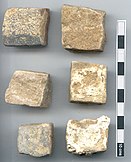
Example of tesserae used in mosaics.
Despite the chronological guild of the advent of these techniques, there is no bodily evidence to suggest that the tessellated necessarily developed from the pebble mosaics.[55]
Opus vermiculatum and opus tessellatum were two different techniques used during this period of mosaic making. Opus tessellatum refers to a redacted tessera (a small block of stone, tile, glass, or other material used in the structure of a mosaic) size followed by an increased variety in shape, color, and material as well as andamento––or the pattern in which the tessera was laid. Opus vermiculatum is oftentimes partnered with this technique but differs in complexity and is known to take the highest visual impact.[54]
The majority of mosaics were produced and laid on site. However, a number of floor mosaics display the employ of the emblemata technique, in which panels of the epitome are created off-site in trays of terra-cotta or stone. These trays were subsequently placed into the setting-bed on the site.[54]
At Delos, colored grouts were used on opus vermiculatum mosaics, but in other regions this is non common. At that place is one example of colored grout used in Alexandria on the Canis familiaris and Askos mosaic. At Samos, the grouts and the tesserae are both colored.
Studying color here is hard every bit the grouts are extremely fragile and vulnerable.
Scientifics research has been a source of interesting information with regard to the grouts and tesserae used in Hellenistic Mosaics. Lead strips were discovered on mosaics equally a definiting characteristic of the surface technique. Lead strips are absent from the mosaics here. At Delos, lead strips were common on mosaics in the opus tessellatum manner. These strips were used to outline decorative borders and geometric decorative motifs. The strips were extremely common on opus vermiculatum mosaics from Alexandria. Because atomic number 82 strips were nowadays in both styles of surface types, they cannot be the sole feature of 1 type or the other.[56]
Tel Dor mosaic [edit]

Detail of mosaic from Tel Dor circa 1st-second centuries. Institute in Ha-Mizgaga Museum in Kibbutz Nahsholim, Israel.
A rare example of virtuoso Hellenistic style moving-picture show mosaic found in the Levantine coast. Through a technical analysis of the mosaic, researchers advise that this mosaic was created by itinerant craftsman working in situ. Since 2000, over 200 fragments of the mosaic accept been discovered at the headline of Tel Dor, withal, the destruction of the original mosaic is unknown.[57] Excavators suggest that earthquake or urban renewal is the cause. Original architectural context is unknown, but stylistic and technical comparisons suggest a late Hellenistic period date, estimating effectually the second half of the second century B.C.E. Analyzing the fragments found at the original site, researchers accept found that the original mosaic contained a centralized rectangle with unknown iconography surrounded by a series of decorative borders consisting of a perspective meander followed by a mask-and-garland edge.[57] This mosaic consists of two different techniques of mosaic making, opus vermiculatum and opus tessellatum.[57]
Alexander mosaic [edit]
An example is the Alexander Mosaic, showing the confrontation of the young conqueror and the Thousand Rex Darius III at the Battle of Issus, a mosaic from a floor in the House of the Faun at Pompeii (now in Naples). It is believed to be a re-create of a painting described by Pliny which had been painted by Philoxenus of Eretria for King Cassander of Macedon at the end of the 4th century BC,[58] or even of a painting by Apelles contemporaneous with Alexander himself.[59] The mosaic allows united states to adore the option of colors along with the composition of the ensemble using turning motion and facial expression.
Stag Hunt mosaic [edit]
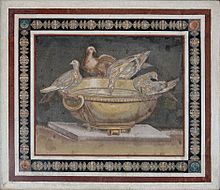
The Stag Hunt Mosaic by Gnosis is a mosaic from a wealthy home of the late fourth century BC, the so-chosen "House of the Abduction of Helen" (or "House of the Rape of Helen"), in Pella, The signature ("Gnosis epoesen", i.e. Gnosis created) is the first known signature of a mosaicist.[60]
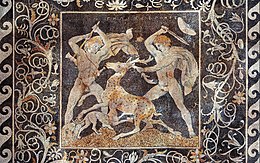
The emblema is bordered by an intricate floral pattern, which itself is bordered by stylized depictions of waves.[62] The mosaic is a pebble mosaic with stones nerveless from beaches and riverbanks which were set into cement.[62] As was perhaps often the example,[63] the mosaic does much to reflect styles of painting.[64] The light figures confronting a darker background may allude to reddish effigy painting.[64] The mosaic also uses shading, known to the Greeks as skiagraphia, in its depictions of the musculature and cloaks of the figures.[64] This forth with its use of overlapping figures to create depth renders the epitome three dimensional.
Sosos [edit]
The Hellenistic period is equally the time of evolution of the mosaic every bit such, peculiarly with the works of Sosos of Pergamon, active in the second century BC and the only mosaic artist cited past Pliny.[65] His taste for trompe-l'œil (optical illusion) and the effects of the medium are establish in several works attributed to him such equally the "Unswept Flooring" in the Vatican museum,[66] representing the leftovers of a repast (fish bones, bones, empty shells, etc.) and the "Pigeon Basin" (fabricated of modest opus vermiculatum tesserae stones)[67] at the Capitoline Museum, known by ways of a reproduction discovered in Hadrian'south Villa.[68] In it 1 sees four doves perched on the edge of a gilt bronze bowl filled with water. One of them is watering herself while the others seem to be resting, which creates effects of reflections and shadow perfectly studied by the artist. The "Dove Basin" mosaic panel is an emblema, designed to be the central point of an otherwise plain mosaic floor. The emblema was originally an import from the Hellenistic eastern Mediterranean, where, in cities such every bit Pergamom, Ephesus and Alexandria, at that place were artists specializing in mosaics.[67] Ane of them was Sosos of Pergamon, the most celebrated mosaicist of antiquity who worked in the second century BC.[67]
Delos [edit]
According to the French archeologist François Chamoux, the mosaics of Delos in the Cyclades represent the zenith of Hellenistic-period mosaic art employing the utilise of tesserae to form complex, colorful scenes.[69] This way of mosaic continued until the end of Antiquity and may have had an impact on the widespread use of mosaics in the Western world during the Middle Ages.[69]
-
-
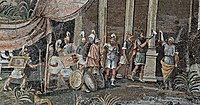
-
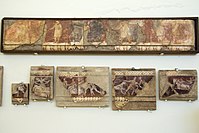
Fragments of landscape paintings from Delos, c. 100 BC
-

The Sampul tapestry, a woollen wall hanging from Lop Canton, Hotan Prefecture, Xinjiang, Mainland china, showing a possibly Greek soldier from the Greco-Bactrian kingdom (250–125 BC), with blue eyes, wielding a spear, and wearing what appears to exist a diadem headband; depicted above him is a centaur, from Greek mythology, a mutual motif in Hellenistic art;[70] Xinjiang Region Museum.
-
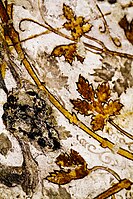
detail of Nabataen ceiling frescoes painted on plastered ceiling.
Pottery [edit]
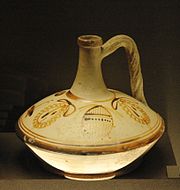
The Hellenistic Historic period comes immediately after the peachy age of painted Ancient Greek pottery, possibly because increased prosperity led to more use of fine metalware (very little now surviving) and the reject of the fine painted "vase" (the term used for all vessel shapes in pottery). Most vases of the period are blackness and uniform, with a shiny appearance approaching that of varnish, decorated with uncomplicated motifs of flowers or festoons. The shapes of the vessels are ofttimes based on metalwork shapes: thus with the lagynos, a wine jar typical of the menstruum. Painted vase types that connected production into the Hellenistic period include Hadra vases and Panathenaic amphora.
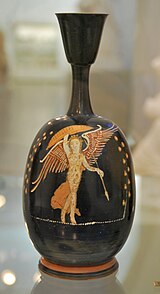
Megarian ware [edit]
Information technology is besides the period of then-called Megarian ware:[72] mold-fabricated vases with decoration in relief appeared, doubtless in imitation of vases made of precious metals. Wreaths in relief were applied to the body of the vase. Ane finds also more than complex relief, based on animals or legendary creatures.
West Slope ware [edit]
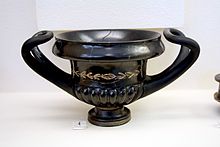
Red-figure painting had died out in Athens past the stop of the fourth century BC to be replaced by what is known as Due west Slope Ware, so named after the finds on the west slope of the Athenian Acropolis. This consisted of painting in a tan coloured skid and white paint on a fired black slip background with some incised detailing.[73]
Representations of people diminished, replaced with simpler motifs such as wreaths, dolphins, rosettes, etc. Variations of this way spread throughout the Greek globe with notable centres in Crete and Apulia, where figural scenes continued to be in demand.
Apulian [edit]

Gnathia vases [edit]
Gnathia vases still were nevertheless produced non only in Apulian, but besides in Campanian, Paestan and Sicilian vase painting.
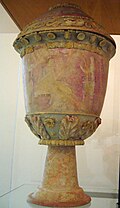
Centuripe vase in Palermo, 280–220 BC
Canosa ware [edit]
In Canosa di Puglia in South Italian republic, in tertiary century BC burials one might find vases with fully iii-dimensional attachments.[74] The distinguishing feature of Canosa vases are the water-soluble paints. Blue, red, yellow, light purple and brownish paints were applied to a white ground.
Centuripe ware [edit]
The Centuripe ware of Sicily, which has been chosen "the terminal gasp of Greek vase painting",[i] had fully coloured tempera painting including groups of figures applied after firing, contrary to the traditional do. The fragility of the pigments prevented frequent utilise of these vases; they were reserved for use in funerals, and many were purely for display, for example with lids that did non elevator off. The do perhaps continued into the 2nd century BC, making it mayhap the last vase painting with meaning figures.[75] A workshop was active until at least the third century BC. These vases are characterized past a base painted pinkish. The figures, frequently female person, are represented in coloured clothing: blueish-violet chiton, yellow himation, white veil. The style is reminiscent of Pompeii and draws more from grand contemporary paintings than on the heritage of the reddish-effigy pottery.
Terracotta figurines [edit]
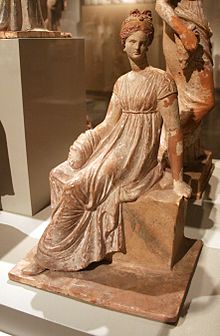
Bricks and tiles were used for architectural and other purposes. Production of Greek terracotta figurines became increasingly important. Terracotta figurines represented divinities likewise every bit subjects from contemporary life. Previously reserved for religious use, in Hellenistic Hellenic republic the terracotta was more oftentimes used for funerary and purely decorative, purposes. The refinement of molding techniques made it possible to create truthful miniature statues, with a high level of detail, typically painted.
Several Greek styles continued into the Roman period, and Greek influence, partly transmitted via the Aboriginal Etruscans, on Ancient Roman pottery was considerable, especially in figurines.
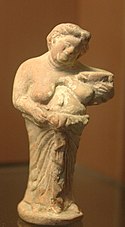
A grotesque woman holding a jar of wine, Kertch, second half of 4th century BC, Louvre.
Tanagra figurines [edit]
Tanagra figurines, from Tanagra in Boeotia and other centers, full of lively colours, most often represent elegant women in scenes full of charm.[76] At Smyrna, in Asia Pocket-sized, two major styles occurred side-by-side: first of all, copies of masterpieces of great sculpture, such as the Farnese Hercules in gilt terracotta.
Grotesques [edit]
In a completely different genre, in that location are the "grotesques", which contrast violently with the canons of "Greek beauty": the koroplathos (figurine maker) fashions deformed bodies in tortuous poses – hunchbacks, epileptics, hydrocephalics, obese women, etc. One could therefore wonder whether these were medical models, the boondocks of Smyrna beingness reputed for its medical school. Or they could simply be caricatures, designed to provoke laughter. The "grotesques" are as mutual at Tarsus and also at Alexandria.
Negro [edit]
1 theme which emerged was the "negro", particularly in Ptolemaic Arab republic of egypt: these statuettes of Blackness adolescents were successful upwardly to the Roman menstruum.[77] Sometimes, they were reduced to echoing a course from the neat sculptures: thus one finds numerous copies in miniature of the Tyche (Fortune or Risk) of Antioch, of which the original dates to the beginning of the 3rd century BC.
Hellenistic pottery designs can exist found in the city of Taxila in modern Pakistan, which was colonized with Greek artisans and potters later Alexander conquered information technology.
-

Female head partially imitating a vase (lekythos), 325-300 BC.
-
Aboriginal Greek terra cotta caput of a beau, establish in Tarent, ca. 300 BC, Antikensammlung Berlin.
-
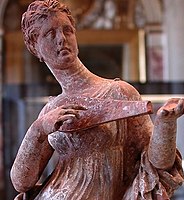
Tanagra figurine playing a pandura, 200 BC
Minor arts [edit]

Metallic art [edit]
Because of so much bronze statue melting, merely the smaller objects withal exist. In Hellenistic Greece, the raw materials were plentiful following eastern conquests.

The work on metallic vases took on a new fullness: the artists competed among themselves with peachy virtuosity. The Thracian Panagyurishte Treasure (from modern Bulgaria), includes Greek objects such as a gold amphora with two rearing centaurs forming the handles.
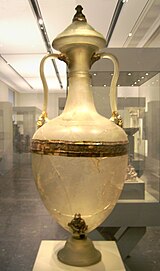
The Derveni Krater, from near Thessaloniki, is a large bronze volute krater from about 320 BC, weighing 40 kilograms, and finely decorated with a 32-centimetre-tall frieze of figures in relief representing Dionysus surrounded by Ariadne and her procession of satyrs and maenads.[78] The cervix is decorated with ornamental motifs while four satyrs in high relief are casually seated on the shoulders of the vase.
The evolution is similar for the art of jewelry. The jewelers of the time excelled at treatment details and filigrees: thus, the funeral wreaths present very realistic leaves of trees or stalks of wheat. In this flow the insetting of precious stones flourished.
Glass and glyptic art [edit]
It was in the Hellenistic period that the Greeks, who until and then only knew molded glass, discovered the technique of drinking glass blowing, thus permitting new forms. Outset in Syria,[79] the art of glass developed specially in Italy. Molded glass continued, notably in the creation of intaglio jewelry.
The fine art of engraving gems hardly advanced at all, limiting itself to mass-produced items that lacked originality. Every bit compensation, the cameo made its appearance. It concerns cutting in relief on a stone equanimous of several colored layers, allowing the object to be presented in relief with more than ane color. The Hellenistic flow produced some masterpieces like the Gonzaga cameo, now in the Hermitage Museum, and spectacular hardstone carvings similar the Loving cup of the Ptolemies in Paris.[80]
Coinage [edit]
Coinage in the Hellenistic period increasingly used portraits.[81]
-
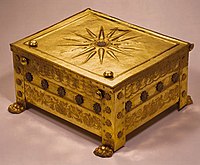
The aureate larnax of Philip II of Macedon which contained his remains. It was constructed in 336 BC. It weighs xi kilos and is made of 24 carat gold. Vergina, Greece.
-
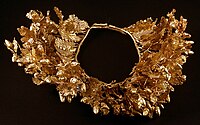
The golden wreath of Philip II establish inside the golden larnax. Information technology weighs 717 grams.
-

The Gonzaga Cameo 3rd century BC, in the Hermitage Museum, St. petersburg
-

Apollonios of Athens, gilt ring with portrait in garnet, c. 220 BC
Later Roman copies [edit]
Spurred by the Roman acquisition, aristocracy consumption and need for Greek fine art, both Greek and Roman artists, specially after the establishment of Roman Greece, sought to reproduce the marble and bronze artworks of the Classical and Hellenistic periods. They did and then by creating molds of original sculptures, producing plaster casts that could exist sent to whatsoever sculptor's workshop of the Mediterranean where these works of art could be duplicated. These were oft true-blue reproductions of originals, yet other times they fused several elements of various artworks into i group, or simply added Roman portraiture heads to preexisting athletic Greek bodies.[82]
-

Drunken old woman clutching a lagynos. Marble, Roman copy afterward a Greek original of the second century BC, credited to Myron.
-
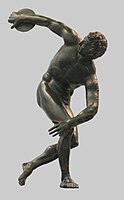
Roman bronze reduction of Myron's Discobolos, 2nd century Advertizing
-
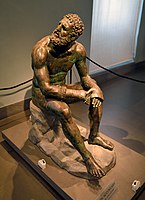
-

Child playing with a goose. Roman copy (1st–2nd centuries AD) of a Greek original, in the Louvre.
-

The Tyche of Antioch. Roman copy later a Greek bronze original by Eutychides of the tertiary century BC.
-
Old market woman, Roman artwork after a Hellenistic original of the 2nd century BC.
-

Crouching Aphrodite, marble copy from the 1st century BC after a Hellenistic original of the 3rd century BC.
-

Artemis of the Rospigliosi type. Marble, Roman artwork of the Imperial Era, 1st–2nd centuries AD. Re-create of a Greek original, Louvre
-
The Farnese Hercules, probably an enlarged re-create fabricated in the early third century AD and signed past a sure Glykon, from an original past Lysippos (or one of his circle) that would take been made in the fourth century BC; the copy was made for the Baths of Caracalla in Rome (defended in 216 AD), where information technology was recovered in 1546
Come across too [edit]
- Alexander the Bang-up
- Hellenistic civilization
- Hellenistic Greece
- Hellenistic period
- Art in ancient Hellenic republic
- Pottery of Ancient Greece
- Ancient Greek vase painting
- Greek sculpture
- Hellenistic influence on Indian art
- Parthian fine art
- Bacchic fine art
References and sources [edit]
- References
- ^ a b Pedley, p. 339 harvnb error: no target: CITEREFPedley (help)
- ^ Burn, p. sixteen harvnb error: no target: CITEREFBurn (help)
- ^ Pollitt, p. 22 harvnb error: no target: CITEREFPollitt (help)
- ^ Bolman 2016, pp. 120–121
- ^ Winter, p. 42
- ^ Anderson, p. 161 harvnb error: no target: CITEREFAnderson (assistance)
- ^ Havelock, p. ? harvnb mistake: no target: CITEREFHavelock (help)
- ^ Pedley, p. 348 harvnb error: no target: CITEREFPedley (help)
- ^ Cahill, Nicholas (2002). Household and Metropolis Arrangement at Olynthus. Yale Academy Press. pp. 74–78. ISBN9780300133004.
- ^ Burn, p. 92 harvnb fault: no target: CITEREFBurn (help)
- ^ Pliny the Elder, Natural History (XXXIV, 52)
- ^ a b Richter, p. 233 harvnb error: no target: CITEREFRichter (assistance)
- ^ Smith, 33–40, 136–140
- ^ Paul Lawrence. "The Classical Nude". p. 5.
- ^ Smith, 127–154
- ^ Green, pp. 39–40 harvnb error: no target: CITEREFGreen (help)
- ^ Boardman, p. 179 harvnb error: no target: CITEREFBoardman (help)
- ^ Studies in the History of Art. National Gallery of Fine art. 1 Jan 1999. ISBN9780300077339 – via Google Books.
- ^ Winter, p. 235
- ^ Paul Lawrence. "The Classical Nude". p. 4.
- ^ Boardman, 199
- ^ Pollitt, p. 110 harvnb error: no target: CITEREFPollitt (help)
- ^ Richter, p. 234 harvnb error: no target: CITEREFRichter (help)
- ^ Singleton, p. 165 harvnb error: no target: CITEREFSingleton (assistance)
- ^ "Scientific American". Munn & Company. 1 January 1905 – via Google Books.
- ^ Fire, p. 160 harvnb mistake: no target: CITEREFBurn (help)
- ^ a b c Pedley, p. 371 harvnb mistake: no target: CITEREFPedley (aid)
- ^ Lessing contra Winckelmann
- ^ Richter, p. 237 harvnb error: no target: CITEREFRichter (assist)
- ^ Klein, Wilhelm (1921). Vom antiken Rokoko (in German). Hölzel: Österreichische Verlagsgesellschaft.
- ^ Klein, Wilhelm (1909). "Die Aufforderung zum Tanz. Eine wiedergewonnene Gruppe des antiken Rokoko". Zeitschrift für bildende Kunst. 20: 101–108.
- ^ Habetzeder, Julia (1 Nov 2021). "The Invitation to the Dance. An intertextual reassessment". Opuscula. Almanac of the Swedish Institutes at Athens and Rome. 14: 419–463. doi:10.30549/opathrom-14-nineteen. ISSN 2000-0898. S2CID 239854909.
- ^ Junker, Klaus (2008). Original und Kopie. Formen und Konzepte der Nachahmung in der antiken Kunst (in German). Wiesbaden: Reichert Verlag. pp. 77–108. ISBN978-3-89500-629-6.
- ^ Smith, 240–241
- ^ Smith, 258–261
- ^ a b Pedley, p. 377 harvnb error: no target: CITEREFPedley (help)
- ^ "Emory Libraries Resources Terms of Use - Emory Academy Libraries". ebookcentral.proquest.com . Retrieved 16 November 2018.
- ^ Schefold, Karl (Summertime 1960). "Origins of Roman Landscape Painting". The Art Bulletin. 42 (two): 87–96. doi:10.1080/00043079.1960.11409078. JSTOR 3047888.
- ^ Ling, Roger (1977). "Studius and the Beginnings of Roman Landscape Painting". The Journal of Roman Studies. 67: 1–sixteen. doi:10.2307/299914. JSTOR 299914.
- ^ "Wind Towers in Roman Wall Paintings" (PDF). metmuseum.org . Retrieved xvi November 2018.
- ^ Rostovtzeff, M. (1919). "Ancient Decorative Wall-Painting". The Journal of Hellenic Studies. 39: 144–163. doi:x.2307/624878. JSTOR 624878.
- ^ a b Rostovtzeff, M (1919). "Ancient Decorative Wall-Painting". The Journal of Hellenic Studies. 39: 144–163. doi:10.2307/624878. JSTOR 624878.
- ^ a b Abbe, Mark B. "Painted Funerary Monuments from Hellenistic Alexandria". In Heilbrunn Timeline of Art History. New York: The Metropolitan Museum of Fine art, 2000–. http://www.metmuseum.org/toah/hard disk drive/pfmh/hd_pfmh.htm (April 2007)
- ^ http://www.metmuseum.org/toah/hd/haht/hd_haht.htm
- ^ a b c d east f Kakoulli, Ioanna (2002). "Late Classical and Hellenistic painting techniques and materials: a review of the technical literature". Studies in Conservation. 47 (Supplement-1): 56–67. doi:x.1179/sic.2002.47.Supplement-one.56. ISSN 0039-3630. S2CID 191474484.
- ^ a b Palagia, Olga. ""THE Royal COURT IN Aboriginal MACEDONIA: THE Testify FOR Imperial TOMBS," in A. Erskine et al. (eds.), The Hellenistic Court (Bristol 2017)".
- ^ Pollitt, p. 40 harvnb error: no target: CITEREFPollitt (help)
- ^ a b Alberge, Dalya (21 August 2010). "Discovery of ancient cave paintings in Petra stuns art scholars". The Observer . Retrieved 14 April 2015.
- ^ Fowler, Harold North; Wheeler, James Rignall; Stevens, Gorham Phillips (1909). A Handbook of Greek Archaeology. Biblo & Tannen Publishers. ISBN9780819620095.
- ^ Chisholm, Hugh (1913). The Britannica Year Book. Encyclopœdia Britannica Visitor, Express.
- ^ Bruno, p. 1 harvnb error: no target: CITEREFBruno (assist)
- ^ a b Bruno, Vincent J. (1985). Hellenistic Painting Techniques: The Evidence of the Delos Fragments. BRILL. ISBN978-9004071599.
- ^ Harding, Catherine (2003). "Mosaic | Grove Fine art". i. doi:x.1093/gao/9781884446054.commodity.t059763. ISBN978-ane-884446-05-4 . Retrieved sixteen November 2018.
- ^ a b c d e Harding, Catherine (2003). "Mosaic | Grove Art". ane. doi:ten.1093/gao/9781884446054.article.t059763. ISBN978-1-884446-05-4 . Retrieved 28 November 2018.
- ^ Dunbabin, Katherine Thou. D. (1979). "Technique and Materials of Hellenistic Mosaics". American Journal of Archaeology. 83 (3): 265–277. doi:10.2307/505057. JSTOR 505057. S2CID 193097937.
- ^ Wootton, Volition (Spring 2012). "Making and Meaning: The Hellenistic Mosaic from Tel Dor". American Periodical of Archæology. 116 (2): 209–234. doi:ten.3764/aja.116.ii.0209. JSTOR ten.3764/aja.116.2.0209. S2CID 194498598.
- ^ a b c Wooton, Will (2012). "Making and Significant: The Hellenistic Mosaic from Tel Dor". American Journal of Archeology. 116 (2): 209–234. doi:10.3764/aja.116.2.0209. JSTOR 10.3764/aja.116.2.0209. S2CID 194498598.
- ^ Pliny the Elder, Natural History (XXXV, 110)
- ^ Kleiner, p. 142 harvnb error: no target: CITEREFKleiner (assistance)
- ^ Mosaics of the Greek and Roman world By Katherine M. D. Dunbabin pg. xiv
- ^ Chugg, Andrew (2006). Alexander's Lovers. Raleigh, N.C.: Lulu. ISBN 978-1-4116-9960-1, pp 78–79.
- ^ a b Kleiner and Gardner, pg. 135
- ^ "The history of mosaic art".
- ^ a b c Kleiner and Gardner, pg. 136
- ^ Pliny the Elder, Natural History (XXXVI, 184)
- ^ "Asarotos oikos: The unswept room".
- ^ a b c "Fine art and sculptures from Hadrian's Villa: Mosaic of the Doves". FOLLOWING HADRIAN. thirteen June 2014. Retrieved 26 November 2018.
- ^ Havelock, p. ? harvnb error: no target: CITEREFHavelock (aid) [ verification needed ]
- ^ a b Chamoux 2002, p. 375
- ^ Christopoulos, Lucas (August 2012). "Hellenes and Romans in Ancient China (240 BC – 1398 AD)", in Victor H. Mair (ed), Sino-Platonic Papers, No. 230. Chinese Academy of Social Sciences, University of Pennsylvania Department of East Asian Languages and Civilizations. ISSN 2157-9687, pp. fifteen–16.
- ^ Fletcher, Joann (2008). Cleopatra the Neat: The Woman Behind the Legend. New York: Harper. ISBN 978-0-06-058558-7, image plates and captions between pp. 246-247.
- ^ Pedley, p. 382 harvnb error: no target: CITEREFPedley (help)
- ^ Burn down, p. 117 harvnb error: no target: CITEREFBurn (assistance)
- ^ Pedley, p. 385 harvnb fault: no target: CITEREFPedley (help)
- ^ Von Bothner, Dietrich, Greek vase painting, p. 67, 1987, Metropolitan Museum of Art (New York, N.Y.)
- ^ Masseglia, p. 140 harvnb error: no target: CITEREFMasseglia (help)
- ^ 3 Centuries of Hellenistic Terracottas
- ^ Burn, p. thirty harvnb error: no target: CITEREFBurn (assist)
- ^ Honour, p. 192 harvnb mistake: no target: CITEREFHonour (aid)
- ^ Pollitt, p. 24 harvnb error: no target: CITEREFPollitt (help)
- ^ "Hellenistic Coin Portraits".
- ^ Section of Greek and Roman Art (Oct 2002). "Roman Copies of Greek Statues." In Heilbrunn Timeline of Art History. New York: The Metropolitan Museum of Art. Retrieved 17 Oct 2016.
- ^ Capitoline Museums. "Colossal statue of Mars Ultor also known every bit Pyrrhus - Inv. Scu 58." Capitolini.info. Retrieved eight Oct 2016.
- Sources
- This article draws heavily on the fr:Art hellénistique article in the French-language Wikipedia, which was accessed in the version of ten November 2006.
- Anderson, William J. (1 June 1927). The Architecture of Ancient Greece. London: Harrison, Jehring, & Co. ISBN978-0404147259.
- Boardman, John (1989). Greek Art . London: Thames and Hudson. ISBN978-0-500-20292-0.
- Boardman, John (eighteen November 1993). The Oxford History of Classical Art. Oxford University Press. ISBN0-nineteen-814386-ix.
- Bolman, Elizabeth Southward. (2016). "A Staggering Spectacle: Early Byzantine Aesthetics in the Triconch". In Bolman, Elizabeth S. (ed.). The Red Monastery Church: Beauty and Asceticism in Upper Arab republic of egypt. New Haven & London: Yale Academy Printing; American Research Eye in Egypt, Inc. pp. 119–128. ISBN978-0-300-21230-iii.
- Bruno, Vincent Fifty. (1985). Hellenistic Painting Techniques: The Testify of the Delos Fragments. ISBN978-9004071599.
- Burn, Lucilla (2005). Hellenistic Fine art: From Alexander The Great To Augustus. Los Angeles: J. Paul Getty Trust Publications. ISBN978-0-89236-776-4.
- Chamoux, Françios (2002) [1981]. Hellenistic Culture. Translated by Michel Roussel. Oxford: Blackwell. ISBN978-0631222422.
- Charbonneaux, Jean, Jean Martin and Roland Villard (1973). Hellenistic Greece. Peter Dark-green (trans.). New York: Braziller. ISBN978-0-8076-0666-7.
{{cite volume}}: CS1 maint: multiple names: authors list (link) - Greenish, Peter (19 Oct 1993). Alexander to Actium: The Historical Evolution of the Hellenistic Age . ISBN978-0520083493.
- Havelock, Christine Mitchell (1968). Hellenistic Art . Greenwich, Connecticut: New York Graphic Order Ltd. ISBN978-0-393-95133-two.
- Holtzmann, Bernard and Alain Pasquier (2002). Histoire de fifty'art antique: fifty'fine art grec. Réunion des musées nationaux. ISBN978-2-7118-3782-3.
- Honour, Hugh (2005). A Earth History of Fine art. ISBN978-1856694513.
- Kleiner, Fred S. (2008). Gardner's Fine art Through the Ages: A Global History. Cengage Learning. ISBN978-0-495-11549-6.
- Masseglia, Jane (2015). Trunk Language in Hellenistic Art and Society. ISBN978-0198723592.
- Pedley, John Griffiths (2012). Greek Art and Archæology. ISBN978-0-205-00133-0.
- Pollitt, Jerome J. (1986). Art in the Hellenistic Age. Cambridge University Printing. ISBN978-0-521-27672-half-dozen.
- Richter, Gisela Thou. A. (1970). The Sculpture and Sculptors of the Greeks .
- Singleton, Esther (1910). Famous sculpture equally seen and described by keen writers. Dodd, Mead & Company.
- Stewart, Andrew (2014). Art in the Hellenistic Globe: An Introduction. Cambridge University Press. ISBN978-1-107-62592-i.
- Winter, Frederick. Studies in Hellenistic Architecture. ISBN978-0802039149.
- Zanker, Graham (2004). Modes of Viewing in Hellenistic Poetry and Art. University of Wisconsin Press. ISBN978-0299194505.
Further reading [edit]
- Anderson, Jane E. A. Body Language in Hellenistic Fine art and Order. Kickoff edition. Oxford: Oxford University Press, 2015.
- Stewart, Andrew F. Art in the Hellenistic World: An Introduction. New York: Cambridge Academy Press, 2014.
- Trofimova, Anna A. Imitatio Alexandri in Hellenistic Fine art: Portraits of Alexander the Great and Mythological Images. Rome: Fifty'Erma di Bretschneider, 2012.
- Zanker, G. Modes of Viewing in Hellenistic Poetry and Art. Madison: Academy of Wisconsin Press, 2004.
External links [edit]
- Selection of Hellenistic works at the British Museum
- Selection of Hellenistic works at the Louvre
- Hellenistic Fine art, Ancient-Greece.org
Source: https://en.wikipedia.org/wiki/Hellenistic_art


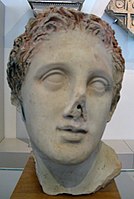


0 Response to "Hellenistic Greek Art Greek Art if Alexander the Great"
ارسال یک نظر